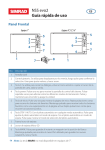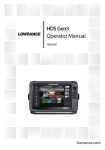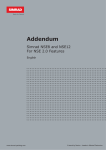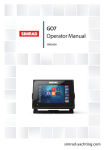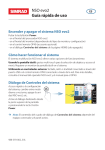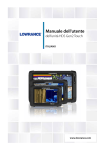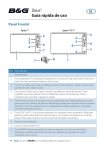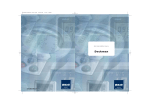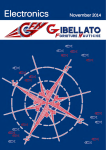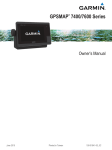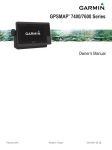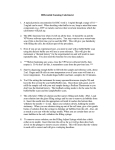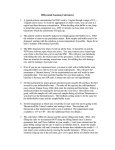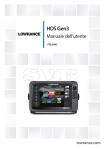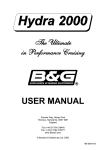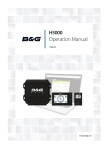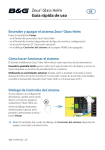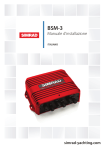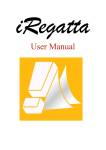Download Zeus User Manual Cover.indd
Transcript
Zeus Multi-function Display User Manual English Preface Disclaimer As Navico is continuously improving this product, we retain the right to make changes to the product at any time which may not be reflected in this version of the manual. Please contact your nearest distributor if you require any further assistance. It is the owner’s sole responsibility to install and use the instrument and transducers in a manner that will not cause accidents, personal injury or property damage. The user of this product is solely responsible for observing safe boating practices. NAVICO HOLDING AS AND ITS SUBSIDIARIES, BRANCHES AND AFFILIATES DISCLAIM ALL LIABILITY FOR ANY USE OF THIS PRODUCT IN A WAY THAT MAY CAUSE ACCIDENTS, DAMAGE OR THAT MAY VIOLATE THE LAW. Governing Language: This statement, any instruction manuals, user guides and other information relating to the product (Documentation) may be translated to, or has been translated from, another language (Translation). In the event of any conflict between any Translation of the Documentation, the English language version of the Documentation will be the official version of the Documentation. This manual represents the product as at the time of printing. Navico Holding AS and its subsidiaries, branches and affiliates reserve the right to make changes to specifications without notice. Copyright Copyright © 2010 Navico Holding AS. Feedback from you Your feedback is important and helps Navico ensure that this manual is a valuable resource for all instrument users. E-mail your comments or suggestions about this manual to the following address: [email protected] Warranty The warranty card is supplied as a separate document. In case of any queries, refer to the brand web site of your display or system: www.bandg.com Declarations and conformance This equipment is intended for use in international waters as well as coastal sea areas administered by countries of the E.U. and E.E.A. For more information refer to the separate Z8/Z12 Installation manual. About this manual This manual is a reference guide for operating the B&G Z8 and Z12 systems. It assumes that all equipment is installed and configured, and that the system is ready to use. The manual assumes that the user has basic knowledge of navigation, nautical terminology and practices. The manual does not cover basic background information about how equipment such as radars, echo sounders and AIS work. Such information is available from our web site: www.bandg.com Important text that requires special attention from the reader is emphasized as follows: Used to draw the reader’s attention to a comment or some important information. Used when it is necessary to warn personnel that they should proceed carefully to prevent risk of injury and/or damage to equipment/personnel. 1 In this manual you will see few direct text references to keys, menus and menu entries, and few step-by-step descriptions. By using graphics we will guide you to the key and the required menu selections. In the illustrations throughout the manual the following symbols are used: Single short press on illustrated key MENU WIN MENU WIN MENU 3s MENU WIN Press twice on illustrated key x2 WIN Press and hold on illustrated key with time indication Rotate rotary knob Single short press on rotary knob References to keys on the operator panel are written in boldface, e.g. ‘WIN’ key. The software This manual is written for B&G Zeus Release to Market 1 (RTM1). Please check web site for details on release version. x2 MENU WIN The About dialogue above is an example only and may not match the software installed on your unit! The manual will be continuously updated to match new software releases. The latest available manual version can be downloaded from www.bandg.com. 2 Contents 1. Overview .................................................................................... 7 Front Panel ..................................................................................... 7 The Zeus Screen Structure ............................................................... 8 Operating Zeus ............................................................................... 9 2. Basic Operation .......................................................................... 11 Turning the Unit On/Off .................................................................. 11 Positioning a Man Over Board Mark .................................................. 11 Adjusting the Backlight .................................................................. 12 Operating the Menu System............................................................ 12 Using the Cursor ........................................................................... 13 Adding Entries in Dialog Boxes ........................................................ 13 Working with Pages and Panels ....................................................... 14 3. Using the Simulator .................................................................... 15 Simulator Mode ............................................................................. 15 Demonstration Mode...................................................................... 15 Selecting simulator source files ....................................................... 15 Advanced Simulator Settings .......................................................... 15 4. Using Charts ............................................................................... 17 The Chart Panel ............................................................................ 17 The Vessel Symbol ........................................................................ 18 Using the Cursor on Chart Panel ...................................................... 18 Extension Lines ............................................................................ 19 Laylines ....................................................................................... 19 Chart Scale .................................................................................. 20 Searching for Chart Objects............................................................ 20 Displaying Chart Information .......................................................... 20 Positioning the Chart on the Panel ................................................... 21 Selecting Chart Details Level .......................................................... 21 Chart Categories ........................................................................... 22 Chart Imagery Style ...................................................................... 22 Chart Overlay ............................................................................... 22 Chart Data ................................................................................... 22 Chart Options in Navionics Chart Database ....................................... 23 Photo Overlay ............................................................................... 23 Navionics Fish’n Chip ..................................................................... 25 3 5. Waypoints, Routes & Tracks........................................................ 26 Waypoints .................................................................................... 26 Tracks.......................................................................................... 27 Routes ......................................................................................... 28 The Waypoints, Routes and Tracks Page ........................................... 29 6. Using the Radar .......................................................................... 30 The Radar Panel ............................................................................ 30 The Radar Operational Modes ......................................................... 31 Setting up the Radar Image ............................................................ 31 Using the Cursor on the Radar Panel ................................................ 32 Optimizing the Radar Image ........................................................... 33 Dual Radar ................................................................................... 34 Target Tracking on Radar and Chart Panels ....................................... 35 True Motion .................................................................................. 35 Fast Scan Mode ............................................................................. 35 Setting a Guard Zone Around Your Vessel ......................................... 36 Other Vessels on the Radar Image ................................................... 37 Measuring Range and Bearing to a Target ......................................... 37 7. Other Vessels on Chart and Radar Image ................................... 39 Target Symbols ............................................................................. 39 How to Display Other Vessels .......................................................... 40 Defining a Guard Zone Around Your Vessel ........................................41 Finding Other AIS Vessels ...............................................................41 8. Echosounder .............................................................................. 42 The Echosounder Image ................................................................. 42 Pausing the Sounder Image ........................................................... 42 Setting Up the Sounder Display ...................................................... 43 Using Colors ................................................................................. 44 Using the Cursor on the Echosounder Panel ...................................... 45 Optimizing the Echosounder Image .................................................. 46 Recording the Echosounder Data ..................................................... 47 9. StructureScan ............................................................................. 49 StructureScan Panel ...................................................................... 49 The StructureScan Image ............................................................... 49 Pausing StructureScan .................................................................. 49 Setting Up the StructureScan Display .............................................. 50 Using Structure Palettes ................................................................. 51 Using the Cursor on the StructureScan Panel .................................... 51 Optimizing the StructureScan Image................................................ 52 Recording the StructureScan Data ................................................... 53 4 10. Navigating .................................................................................. 55 Start Navigating ............................................................................ 55 Cancel Navigation.......................................................................... 55 Navigation Parameters ................................................................... 56 Navigation Panels .......................................................................... 57 Data History ................................................................................. 58 11. Information Panels ..................................................................... 61 Instrument Panels ......................................................................... 61 12. H3000 Performance Functions .................................................... 63 Polar Tables .................................................................................. 63 TWA Correction Table .................................................................... 66 TWS Correction Table .................................................................... 66 13. The Utilities Pages ...................................................................... 67 Vessels ........................................................................................ 67 Alarms ......................................................................................... 67 H3000 Calibration.......................................................................... 68 Satellites ...................................................................................... 68 Find ............................................................................................. 68 Waypoints/routes/tracks ................................................................ 68 Trip Log ....................................................................................... 69 Sun/Moon .................................................................................... 69 Tides ........................................................................................... 69 Files ............................................................................................ 69 14. Customizing Your System ........................................................... 70 Page Setup ................................................................................... 70 Adjusting Panel Size ...................................................................... 72 Setting the Appearance of the Instrument Bar .................................. 72 Changing System Settings .............................................................. 73 15. Weather ...................................................................................... 74 GRIB Weather ............................................................................... 74 GRIB Disclaimer ............................................................................ 77 Setting up the weather image ......................................................... 77 Weather overlay transparency......................................................... 78 Color Codes ................................................................................. 78 Weather Forecast .......................................................................... 78 Weather Alarm Settings ................................................................. 78 5 16. Audio .......................................................................................... 79 Sonic Hub..................................................................................... 79 Sirius Audio .................................................................................. 79 17. Using Video ................................................................................. 81 The Video Panel ............................................................................ 81 Customizing Your Video Settings ..................................................... 81 Optimizing the Video Image ............................................................ 82 Selecting Video Standard ............................................................... 82 18. The Alarm System ....................................................................... 83 Type of Messages .......................................................................... 83 Acknowledging a Message .............................................................. 83 Customizing the Alarm Settings ...................................................... 84 19. Using BEP CZone ......................................................................... 85 The BEP CZone Panel ..................................................................... 86 Operating the Modes Function ......................................................... 87 System Overview Options............................................................... 87 The BEP CZone Dashboard ............................................................. 88 Editing the CZone Dashboard .......................................................... 88 20. Maintenance ............................................................................... 89 Preventive Maintenance.................................................................. 89 Simple Maintenance Procedures ...................................................... 89 Backing Up Your System Data ......................................................... 89 21. Menu Overview ........................................................................... 91 Settings Menus ............................................................................. 91 Context Menus .............................................................................. 92 Plot Menu ..................................................................................... 92 Goto Menu ................................................................................... 92 6 1. Overview Front Panel 2 3 4 6 5 PLOT MARK GO TO VESSEL 7 8 MENU 10 11 WIN IN 1MOB 2 ABC 4 GHI 5 JKL 6 MNO 7 PQRS 8 TUV 9WXYZ STBY AUTO 9 OUT 0 3 DEF 12 PWR 13 CHART RADAR ECHO NAV INFO PAGES 1 1 Direct Access Keys (DAK). Provide direct access to a page. Repeated presses of each DAK cycles through several different pages that relate to the DAK 2 PLOT/MARK key. A short press activates the Plot menu, a long press positions a waypoint at the vessel position 3 Rotary knob. Used to maneuver in the menu system, and for context specific operation 4 GOTO/VESSEL key. A short press activates the Goto menu, a long press centers the chart to vessel position 5 3 (Tick) key. Activates/confirms current selection 6 X (Exit) key. Used to close dialogs, and to return to previous menu level. Toggles between cursor and vessel position on chart panels. Removes the cursor from the screen on radar and echosounder panels 7 Cursor keypad used to move the cursor on the display, and to maneuver in the menu system 8 MENU key. A single press displays the context menu for active panel/overlay/ operation. Pressing the key twice displays the Settings menu 9 WIN key, used on multiple panels pages. A short press toggles between the panels, a long press expands active panel to a full page panel 10 Zoom keys for radar, echosounder and chart pages 11 MOB key. A long press positions a MOB waypoint at the vessel’s position 12 13 Alpha numeric keypad used for entering numbers and text in dialog boxes. NOTE: The STBY/AUTO key is reserved for future use. Power key. A short press activates the Light dialog, a long press turns the unit off 7 The Zeus Screen Structure Pages and page groups The Zeus screen is comprised of page groups, accessed by pressing one of the Direct Access Keys (DAK). A single press of a ‘DAK’ will open the page previously viewed from this ‘DAK’. A second press will give the page group and edit options. CHART RADAR ECHO NAV INFO PAGES Chart Radar Echosounder Navigation Info Utilities Each page group (except the Utilities pages) may include up to 5 pages. The first page in a page group will always be a full screen panel. The system comes pre-configured with some commonly used pages, and you can also define your own pages. Refer to the Customizing your system section. Chart page group example Radar page group example Panels Each application connected to the Zeus system is presented on panels, and you can have up to 4 panels per page. 1-panel page 2-panels page 3-panels page 4-panels page The following panels are available: Panel 8 Description Chart Marine chart. Can be displayed as 2D or 3D (Navionics charts) Radar Radar PPI (Plan Position Indicator) Echo Echosounder Instruments Configurable set of screens representing live data from the vessel. Shown as digits analog/linear gauges Steer Navigation information Video Live video Position GPS Position, SOG/COG and time Wind Plot Shows TWD & TWS over a specific time period Time Plot Shows selected data over a specific time period In addition to these panels the following applications can be connected and displayed on other panels: Application Description AIS AIS information as an overlay on chart and radar panels Weather Weather graphics and data as overlay on chart panel. GRIB Weather Overlay. Sirius Weather application is available in North America only. Audio SonicHub & Satellite radio functions as a panel along the bottom of a page. Sirius Audio application is available in North America only. Instrument bar Sensors connected to the system can be viewed in an instrument bar on top of your screen. Several display options are available for this bar; refer to the Customizing your system section. Operating Zeus The Zeus system communicates with the user by using menus and dialogs. Settings menu The system includes one Settings menu, accessed by pressing the ‘MENU’ key twice. It provides access to system settings, advanced settings for each function and for vessel specific settings. x2 MENU WIN Context menus A context menu contains items that are relevant to the current selection and is accessed by pressing the ‘MENU’ key. MENU WIN Each panel has its own context menu which gives access to basic functions for that panel. Plot menu Used for creating new waypoints, routes and tracks, and for accessing the waypoints, routes and tracks library. PLOT MARK GO TO VESSEL The menu can be accessed independently of the panel that is active. When the ‘PLOT’ key is pressed any other menu action will be interrupted. Goto menu Used to start the navigation function. When the vessel is navigating the menu will be expanded to include options to stop or change navigation. PLOT MARK GO TO VESSEL The menu can be accessed independently of the panel that is active. When the ‘GOTO’ key is pressed any other menu action will be interrupted. 9 Dialogs Dialogs are used for entering user input or for presenting information to the user. A dialog may be presented in full-screen, or as a popup dialog in the centre of the screen. Dependent upon the type of information or entry, different keys are used to confirm, cancel and close the dialog. Alarm messages The Zeus system will continually check for dangerous situations and system faults while the system is running. These are both user definable. When an alarm situation occurs, the Alarm window will popup. If you have enabled the siren, an audible alarm will be activated when any alarm situation occurs. Refer to The alarm system section for further information. 10 2. Basic Operation Turning the Unit On/Off POWER ON STAND BY POWER OFF 3s PWR PWR PWR If you turn the unit ON when no external equipment is connected you will be asked to run in simulator mode. When you turn ON the system after the first-time initialization, the system will start with the same page and settings that were activated when the system was turned OFF. If the radar is running you can turn it to standby mode from within the Light dialog. PWR Positioning a Man Over Board Mark If an emergency situation should occur, you can position a Man Over Board waypoint at the vessel’s current position by pressing and holding the number ‘1’ key. When you activate the MOB function the following actions are automatically performed: - a MOB waypoint is positioned at the vessel’s position - the display switches to a zoomed Chart panel, centered on vessel position - Zeus starts navigating towards the MOB waypoint 3s 1MOB Zeus will continue navigating towards the MOB point until the waypoint is reached or until you select to stop this navigation. PLOT MARK GO TO VESSEL 11 Adjusting the Backlight The backlight for LCD and keys can be adjusted at any time independent of what is on the screen. + or PWR 10 1 PWR MENU WIN 6 3 A night mode is included and optimized for low light conditions. Details on the chart may be less visible when the Night mode is selected! Operating the Menu System Selecting menu item and confirming selection You operate a menu by using the rotary knob to select menu item, and then pressing the knob to confirm your selection. You can also operate the menu by using the arrow keypad to select an item, and then the Tick key to confirm a selection. MENU WIN MENU WIN The illustrations for menu operation throughout this manual will refer to the rotary knob! 12 Exiting the Menu By pressing the X key the menu will return to previous menu level, and then exit. MENU WIN Using the Cursor When you use one of the arrow keys on a Chart, Radar or Echosounder panel the cursor will become visible. The cursor information window will show position coordinates at the cursor position, and range and bearing to the vessel. On an Echosounder panel the cursor information window will include the depth at cursor position. Further use of the cursor is described in the Chart, Radar and Echosounder sections. To remove the cursor and cursor elements from the panel, press the X key. Adding Entries in Dialog Boxes Selecting entry fieldS You switch between the entry fields and keys in a dialog box by using the rotary knob or the arrow keys. You can enter information by pressing the rotary knob or the Tick key when a field is highlighted. Adjusting values You adjust a numeric value in a field by using the keypad, cursor Up/Down or the rotary knob. You need to press the rotary knob first to change the function from selecting fields to editing the slider. Entering text 1MOB 2 ABC 3 DEF 4 GHI 5 JKL 6 MNO 7 PQRS 8 TUV 9WXYZ STBY AUTO 0 IN The alpha numeric keypad is used for entering digits and text in dialog boxes. If digit entries are required the keyboard will input digits only. If both digits and letters are accepted in a dialog repeated short presses on the key will cycle through the letters for that key, while a long press will enter the respective digit. PWR OUT KEY 1st press 2nd press 3rd press 4th press/or press and hold 2 ABC A B C 2 Press the IN key for uppercase letters and the OUT key for lowercase. Depending on the type of information or entry, you can use different keys to confirm the entries. When confirmed or cancelled the dialog box will close. Context help in the dialog boxes When you select an input field, context help for that field will be shown. 13 Working with Pages and Panels Selecting pages You access a page group by pressing the corresponding ‘DAK’ (Direct Access Key). CHART RADAR ECHO NAV INFO PAGES The Active ‘DAK’ is indicated with a green symbol right above the key. When you press a ‘DAK’ for the first time, the default page for that group is displayed. When you later switch between the page groups, the last active page in each group will be displayed. CHART RADAR ECHO A second press of a Direct Access Key will display a list of available pages for that group. Selecting active panel In a split screen you can have multiple panels, but only one panel can be active at a time. You will only be able to access the context menu of the active panel. The active panel is outlined with a green border. MENU You can switch between active panels by pressing the ‘WIN’ key. Maximizing active panel Press and hold the ‘WIN’ key to maximize the selected panel. By pressing the ‘WIN’ key again the panel will return to the previous split screen view. 3s MENU WIN MENU WIN Editing a page You can edit any page in a page group except the first page. You can also define your own pages for each ‘DAK’ as described in the Customizing your system section. 14 WIN 3. Using the Simulator x2 MENU WIN Simulator Mode The simulation mode simulates main data sources, so you can see how the unit works without being connected to echosounder, radar, GPS etc. You can use the simulator to help you become familiar with your unit before using it out on the water. When the simulator is toggled on, this is indicated in the lower part of the display. Demonstration Mode In this mode the unit automatically runs through the main features of the product; it changes pages automatically, adjusts settings, opens menus etc. If you press a key when demo mode is running, the demonstration will pause. After a time-out period, demo mode will resume again. Selecting simulator source files You can select which data files that should be used by the simulator. A set of source files is included in your system, and you can import files by using a USB stick or a memory card. Refer to the utilities pages section. You can also use your own recorded echosounder files in the simulator. For how to record echosounder files, refer to the Using the echosounder section. Advanced Simulator Settings The advanced simulator settings allow you to define how to run the simulator. When the settings are saved these will be used as default when starting the simulator mode. Source files Selects data to be used. A set of source files is included in your system, and you can import files by using a USB stick or a memory card. Refer to The utilities pages section. You can also use your own recorded echosounder files in the simulator. For how to record echosounder files, refer to the Using the echosounder section. GPS source Selects which source file the GPS data is delivered from. Speed, Course and Route Used for manually entering values when GPS source is set to Simulated course or Simulated route. Otherwise, GPS data including speed and course comes from the selected echosounder or radar files. Set start position Moves the vessel to current cursor position. 15 16 4. Using Charts The Chart Panel On the chart panel you can determine your vessel’s position in relation to land. You can use the chart display for planning routes and sailing along a predefined route. The chart function can also display your vessel’s position relative to other chart objects, plan and navigate routes, create waypoints, overlay a radar image and display AIS targets and weather information. GRID LINES * EXTENSION LINE * ROUTE * NORTH INDICATOR RANGE RINGS * WAYPOINT * VESSEL TRACK * CHART RANGE RANGE SCALE x2 MENU WIN * Optional chart image items You turn the optional images on/off individually. 17 The Vessel Symbol When a GPS and a suitable compass sensor is connected to the system, the vessel symbol indicates vessel position and heading. Without a heading sensor fitted, the vessel icon will orientate itself using COG (Course over Ground). If no GPS is available the vessel symbol will include a question mark. Using the Cursor on Chart Panel When you press one of the arrow keys the cursor will become visible, and the cursor position window will be activated. When you are in cursor mode, the chart will not pan or rotate to follow the vessel. Pressing the ‘X’ key will toggle the chart position between the vessel and the previous cursor position. To remove the cursor and cursor elements from the panel, press the ‘X’ key. Selecting objects When you rest the cursor over a chart item, a waypoint, a route or a target, basic information for the selected item will be displayed. By pressing the rotary knob or the tick key when a chart item is selected, all available information about that item will be shown. Popup information has to be enabled. Creating waypoints and routes You can use the cursor to position waypoints and routes as described in the Waypoints, Routes and Tracks section. Extension Lines x2 MENU WIN The vessel’s extension lines can be activated to show course over ground (COG), heading or both. The length of the line indicates either the distance selected or the distance that the vessel will travel at the current speed in selected time period. Selecting Infinite length will project a continuous extension line. COG HEADING Laylines When navigating to a waypoint you can configure laylines on the chart to aid navigation. These lines can be set from the vessel, waypoint or both. x2 MENU WIN To configure the laylines go to the laylines menu. Layline Options Boat: Layline from vessel. The length can be set to 1, 10 or 100 miles. Mark: Layline from mark/waypoint. The length can be set at 1, 10 or 100 miles. If Boat & Mark are selected you cannot set the length as the laylines join at the tack/gybe point where the laylines meet. Tidal Flow Correction: Tidal flow correction will calculate the tidal flow and offset the laylines accordingly. Overlapped: When selected the laylines will extend beyond the tack/gybe intersection. True Wind Angle: There are 3 sources available for true wind angle (TWA). You can choose between Polar, Actual or Manual. Polar: Takes the target TWA from your polar table* (*Polar table is available in Hercules Performance and Hercules Performance Motion only). Actual: Takes the current value of true wind angle (TWA). Manual: Manually input the upwind and downwind numbers into the dialogue boxes. Limits: When selected will show a dotted line indicating the minimum and maximum tack/gybe time period either side of the layline. This can be set from 5 to 30 minutes. 19 Measuring distance MENU WIN The cursor can be used to measure the distance between your vessel and a position or between 2 points on the chart panel. Use the following process to measure a distance. 1 Start the Measure function 2 Move the cursor towards the second measuring point - A line will be drawn from the vessel center to the cursor position, and the distance will be listed in the Cursor Information window You can reset the measurement and start measuring from the cursor position by pressing the Tick key. You terminate the measuring function by pressing the ‘X’ key. Chart Scale You zoom in and out of the chart by using the ‘IN/OUT’ keys or by using the rotary knob. Chart scale will be shown in the lower right corner of the chart panel. Searching for Chart Objects The chart context menu includes a search function used to find and display chart objects. This function is also available from the Utilities pages. Displaying Chart Information You can display available information for the chart and chart items in cursor or vessel position. You can select further details about a selected item by pressing the rotary knob or the Tick key. 20 Positioning the Chart on the Panel Selecting chart center When the cursor is active on the panel, the chart will be centered around the cursor position (cursor mode). Pressing ‘X’ key will remove the cursor, and the chart center will be positioned at the vessel (vessel mode). You can toggle between cursor mode and vessel mode by pressing the ‘X’ key . Panning MENU WIN By moving the cursor to the edge of the panel, the chart will be panned in the cursor’s direction. Look ahead This option centres the chart slightly forward of your vessel so that you can maximise your view ahead. Setting the chart orientation Several options are available for how the chart is rotated in the panel. The chart orientation symbol in the panel’s upper right corner indicates the north direction. North up Displays the chart with the north direction upward. This corresponds to the usual orientation of nautical charts. Heading up Displays the chart with the vessel’s heading directly up on the chart image. Heading information is received from a compass. If heading is not available, then the COG from the GPS will be used. Course up Rotates the chart in the direction of the next waypoint when in navigation mode. This option works only when there’s an active route. If no route is active the heading up orientation will be used until a route is made active. Selecting Chart Details Level Low This is the basic level of information that cannot be removed, and includes information that is required in all geographic areas. It is not intended to be sufficient for safe navigation. Medium This is the minimum information sufficient for navigation. 21 Full This is all available information for the chart in use. Chart Categories This option enables you to select which chart categories you want to display on your chart. Chart Imagery Style The charts can be displayed in two different imagery styles. 2D presents chart information in a basic mapping mode, while the shaded relief option presents chart including terrain information. 2D MENU Shaded relief WIN Chart Overlay Radar and weather information can be displayed as overlay on your chart panel. When one of the overlay options are selected in the chart context menu it will be expanded to include basic function for the selected overlay. Radar, GRIB Weather and Sirius weather functions are described in separate sections in this manual. Chart Data x2 The Zeus system can use Insight and Navionics chart databases. MENU 22 WIN The Navionics chart includes options that are not available in the Insight database. Navionics options are described in the following sections. Chart Options in Navionics Chart Database MENU WIN Chart view The Navionics Platinum and Platinum Plus chart databases provide you with 2D and 3D view options. 2D presents chart information in a basic mapping mode, 3D provides a three dimensional graphical view of land and sea contours. 3D Zooming You zoom in and out of the 3D chart by using the ‘IN/OUT’ keys. Viewing the chart in 3D There are two modes available for moving the camera in 3D views; Vessel mode and Cursor mode. You switch between these two modes by pressing the ‘X’ key. Vessel mode In this mode the camera follows the vessel. The vessel’s position will be in center if not Look ahead option is selected. The camera angle is by default as seen from above and behind the vessel, looking forward. You can tilt the camera by using the up/down arrow keys, but you cannot rotate the camera horizontally. Cursor mode This mode includes two different options for moving the camera; Camera Pan and Camera Rotate. You switch between these two camera modes by pressing the rotary knob or the √ key. Active camera mode is shown on top of the panel. Camera Pan In this mode you move the camera away from the vessel position and around in the chart by using the arrow keys. You can rotate horizontally by using the rotating knob. You can return to vessel position (vessel mode) by pressing the ‘X’ key. Camera Rotate In this mode the camera position is fixed, and the camera can only be rotated. You rotate the camera horizontally by using the left/right arrow keys or the rotating knob. You tilt the camera vertically by pressing the up/down arrow keys. Photo Overlay This option enables you to view satellite photo images of an area as an overlay on the chart. The availability of such photos is limited to certain regions. You can view photo overlays in either 2D or 3D modes. 23 The Photo overlay function is disabled as you zoom out beyond a certain level. Photo transparency The transparency sets the opaqueness of the photo overlay. MENU WIN Optional settings for Navionics charts Annotation Determines what area information is displayed, such as names of locations and notes of areas. Presentation type Provides marine charting information such as symbols, colors of the navigation chart and wording for either International or US presentation types. Chart details Provides you with different levels of geographical layer information. Safety depth The Navionics charts use different shades of blue to distinguish between shallow and deep water. The safety depth sets the limit for which depths that shall be drawn without this blue shading. 24 Contours depth Determines which contours you see on the chart down to the selected contours depth value. Navionics Fish’n Chip MENU WIN Zeus supports Navionics Fish’n Chip (US only). Fish’n Chip provides high resolution bathymetric data. If enabled, you may notice some other chart features disappear and it may clutter the screen. Fish’n Chip data is standard on Navionics Platinum Plus cards. 25 5. Waypoints, Routes & Tracks Waypoints A waypoint is a user generated mark positioned on a chart, on a radar image or on an echosounder image. Each waypoint has an exact position with latitude and longitude coordinates. A waypoint positioned on an echosounder image will in addition to position information have a depth value. A waypoint is used to mark a position you may later want to return to. Two or more waypoints can also be combined to create a route. Placing Waypoints You can place a waypoint at the vessel position from any panel by pressing the ‘PLOT’ key: PLOT MARK - Short press: activates the Plot menu from which you can select the ‘New Waypoint at Vessel’ option. The ‘Edit Waypoint’ dialog is opened allowing the entry of specific details. - Press and hold: plots a waypoint at the vessel’s current position. GO TO VESSEL You can position a waypoint at the cursor position on a chart, radar and echosounder panel by moving the cursor to selected position and then pressing the ‘PLOT’ key. The waypoint dialogs You can enter details for a waypoint in the waypoint dialog, activated by pressing the rotary knob or the Tick key when a waypoint is selected. The waypoints dialog can also be activated from the Waypoint list. Refer The Waypoints, Route and Tracks library later in this section. 26 Moving Waypoints MENU WIN A waypoint can be edited in the Waypoint dialog. You can also move the waypoint manually by using the cursor; 1 Select the waypoint by resting the cursor over it 2 Press the ‘MENU’ key and select the move option 3 Use the arrow keys to move the cursor to a new position 4 Confirm the new position by pressing the rotary knob or the tick key The moving waypoint mode is indicated on top of the panel. The waypoints can also be edited from the Waypoint list as described later in this section. Waypoint alarm settings You can set an alarm radius for each individual waypoint you create. When the waypoint alarm is toggled ON in the alarm panel, an alarm message will be activated when your vessel comes within the defined radius. If you want to set an alarm radius for a route point, it must first be converted to a waypoint. Tracks A track is a graphical presentation of the historical path of the vessel, allowing you to retrace your travel. A track can later be converted to a route in the Tracks dialog described later in this section. x2 MENU WIN From the factory, the system is set to automatically track the vessel’s movement. The system will continue to record the track until the track length reaches the maximum trail point setting, and will then automatically begin overwriting the oldest track points. The automatic tracking function can be turned off from the Tracks library as described later in this section. Track Settings The track is made up of a series of track points connected by line segments whose length depends on the frequency of track recording. You can select to position track points based on time settings, distance, or by letting the Zeus system place track points automatically when a course change is registered. The Tracks option must also be turned ON in the chart settings to be visible! Refer the Chart section. PLOT MARK GO TO VESSEL Creating a New Track You define the track settings and start the new track from the Plot menu. A new track can also be started from the Tracks library described later in this chapter. 27 Routes A route consists of a series of route points waypoints or entered in the order that you want to navigate them. When you rest the cursor over a route, it will turn blue and the route name will be displayed. Creating new routes by using the cursor You can create a new route on the Chart panel as follows: PLOT MARK GO TO VESSEL 1 Press the ‘PLOT’ key and select the new route option 2 Use the arrow keys to move the cursor to the position for the first route point 3 Confirm the position by pressing the tick key or rotary knob 4 Move the cursor to the position for the next waypoints, and confirm the position by pressing the tick key or rotary knob again 5 Repeat moving the cursor and pressing the rotary knob until all waypoints in the route are created 6 Press the ‘MENU’ key to save the route The Edit route mode and route information is indicated on top of the panel until the route is saved. The route can also be created from the Routes list as described later in this section. Editing a route by using the cursor MENU WIN You can edit a route on a chart panel by using the cursor; 1 Select the route by resting the cursor over it - 2 Press the ‘MENU’ key and select the edit option - 3 The Edit route mode and route information is indicated on top of the panel Move the cursor to where you want to make the edit; a waypoint or a leg, and press the ‘MENU’ key again to select edit options - 28 The route will be highlighted The options available in the Edit route menu depend on if the cursor is rested over a waypoint or over a leg 4 Use the cursor to add, move or remove any item 5 Press the ‘MENU’ key again and save your edits The Waypoints, Routes and Tracks Page The Utilities pages includes a Waypoints, Routes and Tracks page. This gives access to advanced edit functions and settings for all these items available on your system. There are several ways to access the library. A couple of them are illustrated below. You move between the tabs in the library by using the left/right arrow keys. The edit and settings options are accessed by pressing the ‘MENU’ key when one of the items is selected. PLOT MARK GO TO VESSEL PAGES 29 6. Using the Radar The radar panel can be set up as a full screen view or combined with other panels. The radar image can also be displayed as an overlay to existing 2D chart views and 3D for Navionics. Refer to the Chart section. The Radar Panel HEADING LINE NE * NORTH INDICATOR IND ATO OR * ROTARY CONTROLS CON ORIENTATION N COMPASS * RANGE ANGE RINGS * x2 MENU RANGE NGE GE MARKERS MARK * * Optional radar symbology WIN You can turn the optional symbology on/off individually. The active symbology can be turned on/off collectively. 30 DATA BAR* MENU WIN The Radar Operational Modes MENU WIN The radar’s operational modes are controlled from the Zeus unit. The following modes are available: Off The power to the radar scanner is turned off Standby The power to the radar scanner in on, but the radar is not transmitting. The radar can also be turned to standby mode by pressing the ‘PWR’ key. PWR Transmit The scanner is on and transmitting to detect surrounding targets. When transmitting detects a target it will be drawn on the radar PPI of the Zeus system. Setting up the Radar Image Positioning the radar center You can move the radar PPI center to different positions within the radar panel. MENU WIN The following options are available: Center Default setting. The radar PPI center is centered on the radar panel. Look Ahead Moves the radar center to the bottom of the panel to give maximum view ahead. Offset Allows you to move the PPI center to any location on the radar panel. 1 Select the offset option 2 Use the arrow keys to position the radar center 3 Confirm the settings with the Tick key Center Look ahead Custom 31 Setting the radar orientation x2 Heading up MENU WIN Rotates the radar image to display the current heading directly up on the radar image. North up Rotates the radar image with North upwards. Course up Rotates the radar image to display the current navigation course directly up. This option works only when the vessel is navigating. If the vessel not is navigating the heading up orientation will be used until the navigation function is started. Setting the radar motion You can select how your vessel symbol moves on the radar image. The radar motion can only be changed when the radar is transmitting. If there’s no heading data or COG, only Relative Motion mode is available. True motion Your vessel, and moving targets, move across the Radar screen as you travel. All stationary objects remain in a fixed position. Relative motion Your vessel remains in a fixed location on the Radar screen and all other objects move relative to your position. You can choose the position of the fixed location, refer as described in Positioning the radar center. Relative motion is the default setting. Changing the image color Different colors (palettes) can be used to represent detail on your radar panel. Using the Cursor on the Radar Panel The cursor is by default not shown on the radar image. When you press one of the arrow keys the cursor will be visible, the cursor position window will be activated. The cursor can be used to measure a distance to a target, and to select targets as described later in this section. To remove the cursor and cursor elements from the panel, press the ‘X’ key. 32 Optimizing the Radar Image You may be able to improve the radar image by adjusting the radar sensitivity, and by filtering the signals from effect of random echoes from sea and weather conditions. The parameters are adjusted by using the rotary knob. You select between the control images by pressing the rotary knob. Active control will expand and display its name in full. You can then adjust the value by turning the knob Gain The gain controls the sensitivity of the radar receiver. A higher gain makes the radar more sensitive to radar returns, allowing it to display weaker targets. If the gain is set too high, the image might be cluttered with background noise. Gain has 2 modes; Auto and Manual. You cycle through the modes by pressing and holding the rotary knob. You can only adjust the gain value by turning the rotary knob when it is in manual mode. Sea clutter Sea clutter is used to filter the effect of random echo returns from waves or rough water near the vessel. When you increase Sea Clutter filtering the on-screen clutter caused by the echoes of waves will be reduced. Sea clutter has 3 modes: auto harbor, auto offshore and manual. A long-press on the rotary knob will cycle through the modes. You can only adjust the clutter value by turning the rotary knob when it is in manual mode. Rain Clutter The Rain clutter is used to reduce the effect of rain, snow or other weather conditions on the radar image. The value should not be increased too much as this may filter out real targets. MENU WIN Rejecting radar interference Interference could be caused by radar signals from other radar units operating in the same frequency band. A high setting will reduce the interference from other radars. In order to not miss weak targets, the interference rejection should be set low when no interference exists. Target boost This feature increases the size of radar targets, making them easier to see on the radar panel. Setting the radar threshold The threshold sets required signal strength for the lowest radar signals. Radar returns below this limit will be filtered and not displayed. Default value: 30%. 33 Dual Radar With dual radar capability in Zeus it is possible for two radar sources to be displayed simultaneously. Connect either two Broadband Radars or two Pulse Radars and see both radar images at the same time. Selecting Dual Radar Mode Set the radar screen to show two radar panels. MENU WIN Highlight a radar panel and select which radar you require from the source select option. You can check which radars are available for selection and set them up by going to Radar Installation. Here you can select each radar and adjust installation settings accordingly. x2 MENU 34 WIN Target Tracking on Radar and Chart Panels MENU WIN Zeus enables you to activate MAPA target tracking through the radar overlay on the chart page. Target tracking on chart panel Target tracking on radar panel True Motion If true motion is selected you will be able to view your vessel moving on the radar screen while the land and it’s environment is stationary. This represents a more ‘real’ representation of the movement of your vessel in relation to surrounding targets. True Motion radar mode, showing trails and MARPA targets Fast Scan Mode If you have a BR24 radar installed on your vessel, you will be able to activate Fast scan. It works by increasing the speed of the BR24 radar scanner when the range is set to 2nm or less. When activated, this option aids in collision avoidance by giving you more updates on target movements within your vicinity. 35 Setting a Guard Zone Around Your Vessel MENU WIN A guard zone is a region (either circular or a sector) that you can define on the radar image. You can also define it if an alarm is activated when a radar target enters or exits the zone. Defining a circular zone 1 Activate one of the guard zones 2 Select circular shape - 3 A circular guard zone will now be positioned on the radar image Select the menu option used for adjusting the zone 4 The menu will be removed from the display, and the rotary symbol for range will be enlarged Use the rotary knob to adjust the range and depth. 5 You switch between the range and depth settings by pressing the rotary knob Press the ‘MENU’ key to save the guard zone settings Defining a sector zone 1 Activate one of the guard zones 2 Select a sector shape - 3 Select the menu option used for adjusting the zone - 36 A sector guard zone will now be positioned on the radar image The menu will be removed from the display, and the rotary symbol for range will be enlarged. 4 Use the rotary knob to adjust the range, depth, bearing and width. You switch between the adjustable settings by pressing the rotary knob 5 Press the ‘MENU’ key to save the guard zone settings Other Vessels on the Radar Image MENU WIN If MARPA radar(s) or AIS devices are connected to the Zeus system, any targets detected by these devices will be displayed as an overlay on the chart and on the radar image. You can also see messages and position for DSC transmitting devices within range. For more information refer to the Other vessels on chart and radar image section. Target tracking Any target detected by the radar may be tracked using MARPA. MENU WIN 1 Select Acquire targets from the menu 2 Position the cursor over the target, and press the ‘tick’ key to confirm 3 Repeat process for more targets 4 Press ‘X’ once you have finished acquiring targets Once your targets are identified, it may take up to 10 radar sweeps to acquire and then track the target. Target setup Target trails You can define how long time the trail that each target leaves should remain on your radar panel. You can also turn OFF target trails. Clearing target trails from the panel MENU WIN You can clear target trails from your radar panel temporarily. The target trails will start to appear again unless you switch them off as described above. Target expansion You can select to increase the size for all thin targets on the radar panels. Measuring Range and Bearing to a Target Using the cursor When you move the cursor on a radar panel the cursor information window will be activated. The cursor window shows range and bearing from your vessel to cursor position. Range rings The range rings are displayed at preset distances from the vessel based on the radar range. You can use the range ring to estimate the distance between a radar echo and your vessel. 37 EBL/VRM MENU WIN The electronic bearing line (EBL) is a line from the center of the vessel. The line’s bearing remains constant as the vessel moves. The variable range marker (VRM) is a usercontrolled range ring that surrounds the vessel. The EBL/ VRM function is used to measure the distance and bearing from the vessel’s position to a target. Two different EBL/VRMs can be placed on the radar image. Positioning an EBL/VRM 1 Move the cursor to a selected object 2 Press the ‘MENU’ key 3 Select one of the EBL/VRM options - - The menu will be removed from the display, and the EBL line and the VRM circle will be drawn on the radar image. The EBL/VRM information window will display range and bearing from the vessel to the marker 4 If required, use the arrow keys to reposition the marker 5 Press the ‘MENU’ key again to save the position You can reposition a fixed EBL/VRM, turn Off the EBL/VRM info window and remove the marker from the same menu. When you reposition the EBL/VRM marker you use the cursor and save the position as described above. Radar overlay You can overlay the Radar image on the Chart. This can help you to easily interpret the radar image by correlating the radar targets with charted objects. When the radar overlay is selected, basic radar operational functions are available from the Chart page’s context menu. More information on Radar Overlay is available in the Using chart section of this manual. 38 7. Other Vessels on Chart and Radar Image If MARPA radar(s) or AIS devices are connected to the Zeus system, any targets detected by these devices can be displayed as an overlay on the chart. You can also see messages and position for DSC transmitting devices within range. You can define alarms to notify you if a target gets too close or if the target is lost. AIS vessels on a chart panel AIS vessels on a radar panel Target Symbols The Zeus system use the target symbols shown below: Symbol Description Sleeping AIS target (not moving or at anchor). Moving and safe AIS target with course extension line. Acquiring MARPA target. Typically it takes up to 10 full rotations of scanner Tracking MARPA target, not moving or at anchor. Tracking and safe MARPA target with extension lines. Dangerous AIS target, illustrated with bold line. Dangerous MARPA target Lost AIS target. Lost MARPA target Selected AIS target, activated by positioning the cursor over a target symbol. Selected MARPA target A target is defined as dangerous based on the CPA, TCPA and AIS Range settings. Refer Defining alarm limits later in this section. When no signals have been received within a time limit a target will be defined as lost. The target symbol represents the last valid position of the target before the reception of data was lost. The target will return to default target symbol when the cursor is moved. 39 How to Display Other Vessels x2 MENU WIN Icon Filters Select which targets to display. Extension Lines Sets the length of the extension lines for your vessel and for other vessels. Heading information is read from active heading sensor, and COG information is as received from an active positioning system. The length of the extension line is either a set distance e.g. 1 mile, OR the distance the vessel will move in the selected time period. COG HEADING COG (Course Over Ground) - Dark Red Line HEADING - Blue Line Speed & Course Selects how to use the extension line to indicate speed and course for targets; either as true motion in the chart or relative to your vessel. AIS Icon Orientation Sets the orientation of the AIS icon; either based on heading or COG information. Receiving MMSI Messages You need to have your own MMSI number entered in the Zeus system to be able to receive addressed messages from AIS and DSC vessels. this prevents your own vessel from being displayed as a dangerous AIS target, if fitted with an AIS transponder. The Vessel message option in the alarm settings must be toggled on if any MMSI message shall be displayed, refer to next page. 40 Defining a Guard Zone Around Your Vessel You can define an invisible guard zone around your vessel. When a target comes within this distance from your vessel, the symbol will change to the “dangerous” target symbol. An alarm will be triggered if activated in the Alarm settings panel. You can also display information about other vessels from the Vessels page as described in the Utilities pages section. MENU WIN Finding Other AIS Vessels You can search for other vessels equipped with suitable AIS devices from your chart menu or from the Find or Vessels feature in the utilities pages (refer to the Utilities pages section). 41 8. Echosounder The Echosounder function provides a view of the water and bottom beneath your vessel, allowing you to detect fish and examine the structure of the sea floor. The Echosounder Image The echosounder displays the water column moving from right to left on the panel. You can select between single panel view and several split views as described later in this chapter. DEPTH FISH ARCHES UPPER RANGE TEMP GRAPH * TEMPERATURE FREQUENCY ZOOM GAIN/ COLOR INDICATORS RANGE SCALE ZOOM BARS * DEPTH LINE * SEA BED MENU WIN LOWER RANGE A-SCOPE * * Optional echosounder image items You turn the optional echosounder images on/off individually. Pausing the Sounder Image It is possible to turn OFF the sounder transmission from the Zeus unit. When the echosounder is connected and configured the sounder information will be transferred to the Zeus system as long as the echosounder is running. You can freeze the sounder image, allowing you to examine the sounder echoes. This function is useful when you need to position a waypoint exactly on the echosounder panel, and if you are using the cursor to measure a distance between 2 elements on the image. When the image is paused the echosounder will continue to run and the depth indication on the panel will be updated. 42 Setting Up the Sounder Display MENU WIN The echosounder panel can be setup as a single view, or with split view where the left and the right side presents different images. Split screen options Zoom The Zoom mode presents a magnified view of the sounder image on the left side of the panel. By default the zoom level is set to 2x. The range zoom bars on the right side of the display shows the range that is magnified. If you increase the zooming factor the range will be reduced. You will see this as reduced distance between the zoom bars. ZOOM LEVEL ZOOM BARS When Zoom mode is selected, the context menu will expand to include a drop down menu from where you can select the zoom factor. Bottom lock The bottom lock mode is useful when you want to view echoes close to the bottom. In this mode the left side of the panel shows an image where the bottom is flattened. The range scale is changed to measure from the seabed (0) and upwards. The bottom and the zero line will always be shown on the left image, independent on range scale. ZERO LINE The scaling factor for the image on the left side of the panel is adjusted as described for Zoom mode. 43 Setting the Echosounder Range The range setting determines the depth shown on the display. MENU WIN Auto If you select Auto, the system will automatically display the whole range from the water surface to the bottom. Auto range will automatically be turned off once you adjust the range manually. Manually changing the range You can increase or decrease the range by pressing the zoom keys. IN OUT Pressing and holding one of the zoom keys will toggle between auto and manual range. Autorange is resumed by pressing the “0” key. When manually change the range the lower depth line will be moved upwards or downwards. The upper depth line will always be at the water surface. This options allows you to focus on echoes at the upper part of the water column. The echosounder frequency This Zeus unit supports several transducer frequencies. Available frequencies depend on what transducer that is connected. You can view two frequencies at the same time by setting up a echosounder split screen. Selecting the ping speed The Ping Speed controls the rate the transducer uses to send echosounder waves into the water. A higher ping speed will yield the best results when you are moving across the water at a high rate of speed or fishing from a dock. The reverberation of too much ping speed can cause interference on the screen. The fish echoes You can select how you want the echoes to appear on the echosounder image. TRADITIONAL FISH ECHOES Using Colors x2 MENU FISH SYMBOLS AND DEPTH INDICATION WIN Color palette Several display color templates with varying degrees of color and brightness are available. Bottom coloring The bottom coloring option colors the entire bottom area in one brown shade. This will clearly separate fish and structure from the bottom. 44 Using the Cursor on the Echosounder Panel The cursor is by default not shown on the sounder image. When you press one of the arrow keys the cursor will be visible, the depth at the cursor position will be shown, the information window and the history bar will be activated. You use the arrow keys to move the cursor in any direction on the display. To remove the cursor and cursor elements from the panel, press the ‘X’ key. Using the cursor to position a waypoint You can position a waypoint at the cursor position by pressing the ‘PLOT’ key as described in the Waypoints, routes and tracks section. When the key is pressed the waypoint symbol and ID are positioned at the cursor position. Viewing sounder history Whenever the cursor is shown on a sounder panel, the green scroll bar is also shown. The scroll bar shows the image you are currently viewing in relation to the total echosounder image history stored. When the scroll bar is on the far right side it indicates that you are viewing the latest soundings. If you move the cursor to the left side of the screen the history bar will start scrolling towards left, and the automatic scrolling as new soundings are received will be turned off. To resume echosounder scrolling, move the cursor to the right until the green history bar reaches the right side of the image, or press the ‘X’ key. Measuring distance MENU WIN The cursor can be used to measure the distance between the position of two observations on the sounder image. It is easier to use the measure function when the sounder image is paused. Use the following process to measure a distance: 1 Move the cursor to the first measuring point 2 Start the Measure function 3 Move the cursor towards the second measuring point - A line will be drawn from the first point to the cursor, and the distance will be listed in the Information window You can reset the measurement by pressing the Tick key. When you press the ‘X’ key the echosounder will resume to normal scrolling. 45 Optimizing the Echosounder Image Several parameters can be adjusted to optimize the sounder image. Gain The gain controls the sensitivity of the echosounder. The more you increase the gain, the more details will be shown on the image. However, a higher gain setting may introduce more background clutter on the image. Conversely, if the gain is set too low weak echoes may not be displayed. Auto gain The Auto gain option will keep the sensitivity at a level that works well under most conditions. With the gain in auto mode, you can set a positive or negative offset that gets applied to the auto gain. This is indicated as A-40 - A40. Color The strength of the echo is symbolized by colors. A strong return will be shown with reddish-brown color, while a weak signal will be light blue (depending on which palette you select). The more you increase the Color, the more echoes will be displayed as reddish-brown. Adjusting the Gain and Color gain settings Gain and Color are adjustable by using the rotary knob. You select between Gain and Color by pressing the rotary knob. The active control will expand and display it’s name in full. You can then adjust the value by turning the knob. If you press and hold the rotary knob when Gain is selected, you switch between Auto and Manual gain option. PLOT MARK GO TO VESSEL If no adjustments are made within 3 seconds the controls will return to default size. Noise rejection Echosounder signal interference from bilge pumps, engine vibration and air bubbles can clutter the sounder image. The noise rejection option filters the impact of echosounder signal interference by reducing the on-screen clutter. 46 Clarity MENU WIN Wave action, boat wakes and temperature inversion can cause on-screen clutter near the surface. The surface clarity option reduces surface clutter by decreasing the sensitivity of the receiver near the surface. Recording the Echosounder Data You can record echosounder data and save the file internally in the Zeus unit. You can select how many bytes per seconds that is to be used when saving the log file. More bytes yields better resolution, but will cause the record file to increase in size compared to using lower byte settings. When the echosounder image is being recorded, there will be a flashing red symbol and a logging message will appear periodically at the bottom of the screen. The sounder recording is stopped by repressing the ‘MENU’ key. 47 Viewing the recorded sounder data The recorded sounder images are stored internally in the Zeus unit, and can be reviewed when selected. The log file is displayed as a paused image, and you get access to the replay and echo options by pressing the ‘MENU’ key. You exit the replay mode by pressing the ‘X’ key. 48 9. StructureScan StructureScan provides underwater panoramic views from your vessel that are not available in normal echosounder functionality. StructureScan must be activated in Advanced setup in the System Settings menu before the StructureScan display and menu items are available on the Zeus unit. StructureScan has two functional views: Sidescan and DownScan; both views can be used in conjunction with your Zeus echosounder to provide more sonar imaging options. StructureScan can save waypoints, review history and create sounder logs. StructureScan Panel StructureScan is accessed via the ECHO key. x2 ECHO StructureScan can also be set up in one of the other page groups accessed by the ‘DAK’ keys. It can be set up as a single panel or as one of the panels in a mult-panel page. The StructureScan Image StructureScan enables you to view under your vessel; it provides extra views on the panel, either moving from right to left on the panel (SideScan mode), or from top to bottom (DownScan mode). SIDESCAN (LEFT ONLY) DOWNSCAN (DOWN) Pausing StructureScan MENU WIN It is not possible to turn OFF the StructureScan transmission from the Zeus unit. When the StructureScan is connected and configured the StructureScan information will be transferred to the Zeus system as long as structureScan is running and connected. You can freeze the StructureScan image, allowing you to examine the structures and other images in more depth and detail. This function is useful when you need to position a waypoint exactly on the Structurescan SideScan or DownScan views, and if you are using the cursor to measure a distance between 2 elements on the image. When the image is paused, it will continue to run and the depth reading on the panel will be updated. 49 Setting Up the StructureScan Display The StructureScan panel can be setup with different views; either as a single view (Left Only, Right Only or Down), or double view (Left + Right) this view presents the left and right side of your vessel underwater. MENU WIN SideScan Enables you to view the structure and terrain without having to navigate your vessel over the top of your destined course. It has high-resolution detail with 152 m side-to-side underwater views. It is designed to cover more water in less time; and provide views in both the left and right sides under your vessel, using the water column in centre of display. DownScan Broadcasts a beam downwards that displays a high-detail sonar image scanning focused down below your vessel. It provides you with the same high resolution that is displayed from right to left of display panel. Zoom You can select different zooming levels on the StructureScan image. SELECTED ZOOM LEVEL By default the zoom level is set to Off. Setting StructureScan range The range setting determines the depth shown on the display. Auto If you select Auto, the system will automatically display the whole range from the water surface to the bottom. Auto range will automatically be turned off once you adjust the range manually. Manually changing the range You can increase or decrease the range by pressing the zoom keys. IN OUT Pressing and holding one of the zoom keys will toggle between auto and manual range. Autorange is resumed by pressing the “0” key. When manually changing the range the lower depth line will be moved upwards or downwards. The upper depth line will always be at the water surface. This options allows you to focus on echoes at the upper part of the water column. The StructureScan frequency Structurescan supports transducer two frequencies. 455kHZ is ideal for greater depth and distance and 800kHZ provides better definition. 50 Using Structure Palettes Several display structure templates with varying degrees of color and brightness are available. x2 MENU WIN Using the Cursor on the StructureScan Panel When you press one of the arrow keys the cursor will be visible, the depth at the cursor position will be shown, the information window and the history bar will be activated. You use the arrow keys to move the cursor in any direction on the display. To remove the cursor and cursor elements from the panel, press the ‘X’ key. Using the cursor to position a waypoint You can position a waypoint at the cursor position by pressing the PLOT key as described in the Waypoints, routes and tracks section. When the key is pressed the waypoint symbol and ID are positioned at the cursor position. Viewing StructureScan history Whenever the cursor is shown on a StructureScan panel, the green scroll bar is also shown. The scroll bar shows the image you are currently viewing in relation to the total StructureScan image history stored. Depending of the view selected either DownScan or SideScan modes— when the scroll bar is on the far right side (DownScan) or at the bottom of the screen (SideScan)— all indicates that you are viewing the latest soundings. Therefore, if you move the cursor to the left side of the screen (DownScan mode) the history bar will start scrolling towards left, and the automatic scrolling as new soundings are received will be turned off. Conversely, if you move the cursor upwards (in SideScan mode) the history bar will start scrolling upwards, and the automatic scrolling as new soundings are received will be turned off. To resume StructureScan scrolling, move the cursor until the green history bar reaches either the right side of the image (DownScan) or bottom of the image (SidenScan), or press the ‘X’ key. Measuring distance MENU WIN The cursor can be used to measure the distance between the position of two observations on the StructureScan image. It is easier to use the measure function when the sounder image is paused. Use the following process to measure a distance: 1 Move the cursor to the first measuring point 2 Start the Measure function 3 Move the cursor towards the second measuring point - A line will be drawn from the first point to the cursor, and the distance will be listed in the Information window You can reset the measurement by pressing the Tick key. When you press the ‘X’ key the echosounder will resume to normal scrolling. 51 Optimizing the StructureScan Image Several parameters can be adjusted to optimize the StructureScan image. Color The strength of the echo is symbolized by colors. A strong return will be shown with a reddish-brown color, while a weak signal will be light blue (depending on which palette you select). The more you increase the color, the more echoes will be displayed as reddish-brown. Adjusting the color settings Color is adjustable by using the rotary knob. The active control will expand and display it’s name in full. You can then adjust the value by turning the knob. If no adjustments are made within 3 seconds the controls will return to default size. Noise rejection StructureScan signal interference from bilge pumps, engine vibration and air bubbles can clutter the StructureScan image. The noise rejection option filters the impact of StructureScan signal interference by reducing the on-screen clutter. Flip left/Right function This function controls the orientation of both StructureScan functions: SideScan and DownScan. If your transducer is installed with the cable end pointing away from the back of your vessel; the Flip left/right function will ensure that what is on the left or right side of your vessel matches what is on your display. MENU WIN Clarity Wave action, boat wakes and temperature inversion can cause on-screen clutter near the surface. The surface clarity option reduces surface clutter by decreasing the sensitivity of the receiver near the surface. 52 Recording the StructureScan Data You can record structurescan data and save the file internally in the Zeus unit. x2 MENU WIN You can select how many bytes per seconds that are to be used when saving the log file. More bytes yield better resolution, but will cause the record file to increase in size compared to using lower byte settings. When the StructureScan image is being recorded, there will be a flashing red symbol and a logging message will appear periodically at the bottom of the screen. Recording Symbol Logging Message The sounder recording is stopped by repressing the ‘MENU’ key. 53 Viewing the recorded sounder data The recorded sounder images are stored internally in the Zeus unit, and can be reviewed when selected The log file is displayed as a paused image, and you get access to the replay and echo options by pressing the ‘MENU’ key. You exit the replay mode by pressing the ‘X’ key. 54 10. Navigating The navigation function included in the Zeus allows you to navigate towards the cursor position, a position defined by latitude and longitude values, a waypoint or along a predefined route. For information about positioning waypoints and creating routes, refer the Waypoints, Tracks and Routes section. PLOT MARK GO TO VESSEL Start Navigating Using the GOTO key You can start navigation from any panel by pressing the ‘GOTO’ key. The ‘GOTO’ cursor option will only be available when the cursor is active on a Chart, Radar or Echosounder panel. Using the cursor You can start navigating a route on a chart panel by moving the cursor over the route and then pressing the ‘MENU’ key. MENU WIN Selecting start point You can navigate a route starting from any waypoint by positioning the cursor over the selected waypoint and pressing the ‘MENU’ key. MENU WIN Cancel Navigation You cancel navigation by pressing the ‘GOTO’ key and selecting ‘Cancel navigation’. PLOT MARK GO TO VESSEL 55 Navigation Parameters x2 MENU WIN Navigation method Different methods are available for calculating the distance and bearing between any two points on a chart. The great-circle route is the shortest path between two points. However, if you are to travel along such a route, it would be difficult to steer manually as the heading would constantly be changing (except in the case of due north, south, or along the equator). Rhumb lines are tracks of constant bearing. It is possible to travel between two locations using Rhumb line computation, but the distance would usually be greater than if Great circle is used. Steering alarm limits Arrival radius Sets an invisible radius around the destination waypoint. When the arrival alarm is activated, an alarm will appear when the vessel is within this radius. Off course limit This parameter defines the vessel’s accepted offset distance from the leg. If the vessel goes beyond this limit an alarm will be activated. Off course alarm must be enabled/disabled in the alarm panel. Magnetic variation Converts magnetic North data to true North. Auto automatically converts magnetic north to true north. When using manual mode, you will have to input the local magnetic variance. Datum Most paper charts are based on the WGS84 datum, Zeus also uses WGS84. If your paper charts are based on a different datum you can change the setting in the Zeus system to match your paper charts. Coordinate system Controls the format of lat/lon coordinates displayed on the panels. Phantom Loran Enables phantom loran, for waypoint entry, vessel and cursor position display. Loran settings Allows setting of GRI and preferred TD pairs for vessel and cursor position display. 56 Navigation Panels The Steer and Position panels can be used to display information when you are navigating. The Steer panel DATA FIELDS USE LEFT/ RIGHT ARROW TO TOGGLE VESSEL SYMBOL COURSE LINE OFF COURSE LIMIT Data fields The Steer panel offers the following information: DTD Distance to destination BTW Bearing to waypoint SOG Speed over ground COG Course over ground TTD: Time to destination ETA: Estimated time of arrival at next waypoint VMG: Velocity Made Good towards next waypoint. STEER: Course to steer towards next waypoint The course line When travelling on a route the course line shows the intended course from one waypoint towards the next. When navigating towards a waypoint (cursor position, MOB or an entered lat/ lon position), the course line will show the intended course from the point at which navigation was started towards the next waypoint. Vessel symbol The vessel symbol indicates distance and bearing relative to the intended course. Off course limit If the XTE exceeds the defined off course limit (refer below), this will be indicated with a red arrow including the distance from the track line If the off course alarm is enabled, the alarm will activate if the XTE exceeds the defined off course limit. 57 Position panel Data fields • Position in Latitude/Longitude • Time • Date • SOG • COG Data History Data history, wind and time plots can be accessed via the info page. x2 INFO Heading Apparent Wind Angle True Wind Speed True Wind Speed True Wind Direction Above is an example of the history data page. There are 2 standard layouts. Layout 1 displays 4 Time Plots alongside the Wind Plot, layout 2 displays 3 Time Plots alongside the Wind Plot. You can change between layout 1 and 2 via the info menu.” 58 Editing the Time Plot / Wind Plot Info Page All of the data windows can be configured to show the data you require via the edit menu. MENU WIN Select the data field you wish to change. MENU WIN Select the required information. MENU WIN Saving the changes will return you to the wind and time plot screen, displaying the new configuration. You can cancel the changes at anytime before you save by selecting cancel. 59 Missing Data If instrument data is unavailable the time plot will turn into a dashed line and flatten out at the point data was lost. When data becomes available again a dashed line will join up the two points showing an average trend line where the missing data is. Barometric Pressure data is stored on the unit even if power is switched off. This enables the unit to display data from a previous day. Data is not recorded whilst the unit is off. 60 11. Information Panels Instrument Panels The instrument panel consists of multiple gauges — analog, digital and bar — that can be customized to display selected data. The instrument panel displays data on dashboards, and you can define up to ten dashboards within the instrument panel. MENU WIN Switching Between Dashboards You switch between a panel’s dashboards by using the left and right arrow keys or by selecting the dashboard from the menu. MENU WIN Dashboard Styles Four dashboard layouts are predefined to display gauges showing relevant information for sail, navigation, cruise and race environments. 1. Sail dashboard 2. Navigation dashboard 3. Cruise dashboard 4. Race dashboard Adding dashboards MENU WIN There can be up to 10 dashboards within each instrument panel. In addition to the 4 predefined dashboards you can design your own based on the predefined dashboard styles. 61 Customizing a Dashboard You can customize a dashboard by changing the dashboard style, and by changing the data for each of the gauges in the dashboard. You can also set limits of analog gauges. MENU WIN Available editing options will depend on type of gauge and which data sources that are connected to your system. When a dashboard is in editing mode, this will be indicated in the upper right corner Select the data field you wish to change. MENU WIN Select the required information. MENU WIN Saving the changes will return you to the dashboard screen, displaying the new configuration. You can cancel the changes at anytime before you save by selecting cancel. 62 12. H3000 Performance Functions When connected to H3000 instruments via H-Link and H-Link Comms switched on you can access the H3000 Calibration menu. In H3000 Calibration you can edit the true wind angle correction and true wind speed correction tables. You can also load and edit polar tables via this menu (Hercules Performance & Hercules Motion Only). Polar Tables The H3000 instrument system has the ability to store a polar table in its memory. Multiple polar tables can be saved on your Zeus unit and can be loaded from there onto your H3000 CPU. Note: Only one table can be used at any one time. Loading a Polar Table to Zeus Memory Insert a USB stick or Memory card that contains a polar table into the USB/Card port on the front of the Zeus unit. To view the contents go to Files menu. Ensure ‘Memory Card - USB Front’ is highlighted and press the right arrow key to enter. Use the arrow keys to highlight the required polar file. MENU MENU WIN WIN 63 Press ‘Menu’ Select ‘Copy” and press enter. Once you have selected the file from your portable memory, highlight the polar directory on the Zeus unit using the arrow keys. Press enter to copy the polar file to the polar directory. It will now appear in the polar directory. Loading a Polar Table from Zeus into H3000 Go to H3000 Calibration in the ‘Pages’ menu. Select ‘Polars’. The file entitled ‘H3000 Polar Data’ will always be your current file loaded on H3000. Highlight the polar file you want to load onto your H3000 system. Select ‘Menu” Highlight ‘Load into H3000” and press ‘Enter’. This action will overwrite the polar stored in H3000. We recommend you backup your polar files. (See next page). 64 Editing a Polar Table It is possible to edit a polar table via Zeus to match the performance of your boat to improve the consistency of the data and performance of your instrument system. You can edit the polar numbers by row or by cell. To edit a polar table select the table you wish to edit via the H3000 Calibration menu. Press ‘Menu’ ‘Edit’ Use the arrow keys to navigate the cells of the polar table. Highlight the cell you wish to edit and use the rotary knob to adjust the number up or down as desired. Alternatively pressing menu on the highlighted number will open an edit dialogue box and the number can be adjusted via that. To edit an entire row by the same percentage highlight the cell to the far left of the row under the TWS header. Press ‘Menu’ adjust the percentage with the rotary knob. Press ‘Enter’ to complete. Backup a Polar Table To backup the current polar data being used by H3000, highlight ‘H3000 Polar Data’ in the polars menu. Press ‘Menu’ Select ‘Backup’ Name the file accordingly. 65 TWA Correction Table The TWA Correction table receives its information from the H3000 instrument data and does not store this information on the Zeus unit. Any changes made to this table via Zeus will automatically change the H3000 instruments and be stored on H3000. Editing the TWA Correction Table Select the field you wish to edit using the arrow keys. Turn the rotary knob to adjust the number. Change all cells accordingly. When complete press ‘Menu’ and select save to save your changes. TWS Correction Table The TWS Correction table receives its information from the H3000 instrument data and does not store this information on the Zeus unit. Any changes made to this table via Zeus will automatically change the H3000 instruments and be stored on H3000. Editing the TWS Correction Table Select the field you wish to edit using the arrow keys. Turn the rotary knob to adjust the number. Change all cells accordingly. When complete press ‘Menu’ and select save to save your changes. 66 13. The Utilities Pages The utilities pages include options and tools that are not specific to any panel. These pages act different to the chart, radar, echo etc. They are always full screen, and you cannot use them in a split page with any other panels. A utility page will open on top of your previous page. When you close a dialog in one of the utilities pages the utilities function will close and the display will return to last active page. The utilities pages are accessed and operated as for normal menu operation. You switch between different tabs in a page by using the arrow keys. You can also access a page by using the numeric key as indicated on each icon. Any listing in the utilities pages has a context menu, giving access to available options for the selected item. The context menu is displayed by pressing the ‘MENU’ key. Vessels Status listing List of all AIS, MARPA, and DSC vessels with available information. Message listing List of all messages received from other AIS vessels with time stamp. Alarms Active alarms List of active alarms. Alarm history List of all alarms with time stamp. Alarm settings List of all available alarm options in the system, with current settings. 67 H3000 Calibration Polars Select, edit or backup polar data TWA Correction True Wind Angle correction table TWS True Wind Speed correction table Satellites When selected you will see the status page for active satellites. When H-Link is disabled the H3000 Calibration icon is replaced with Satellites icon. Find Search function for several chart items. By pressing the MENU key you get access to available options for the selected item. Waypoints/routes/tracks List of waypoints, routes and tracks with details. 68 Trip Log Trip 1 / Trip 2 Displays voyage and engine information, with reset option for all data fields. Today Displays voyage and engine information for current date. All data fields will be automatically reset when the date changes. Sun/Moon Displays sunrise, sunset, moonrise and moonset for a position based on entered date. Tides Displays tide information for the tide station nearest to your vessel. You can use the arrow keys to page to selected date. Available tide stations can be selected by using the MENU key. Files File management system for files, waypoints, routes, tracks and settings. By pressing the MENU key you get access to available options for the different file types. 69 14. Customizing Your System Page Setup Your Zeus system includes a set of predefined pages for each page group accessed by the Direct Access Key (DAK). The list of available pages is displayed when you press the ‘DAK’ for the active page. Each page group can have up to 5 pages, organized as single panels or as a combination of panels. The first item in each page list will always be a full size page for the panel related to that page group. There can be up to 4 panels on each page, and the layout can be arranged as illustrated below. The numbers indicated on each page shows the order in which the panels will be added. 1 1 2 1 2 1 2 3 4 3 The graphics on the next page illustrates how a page is added and panels defined for the RADAR page group. The process is identical for each page group. You can add, remove and replace panels from the same menu. The illustration does not indicate how you use the rotary knob to maneuver in the menu and confirm a selection. This is described in the Basic Operation section. 70 RADAR MENU WIN MENU WIN 71 Adjusting Panel Size You can adjust the size of the panels in a multi panel’s page by pressing the page group’s ‘DAK’. The illustration below shows how you change the size of a 3-panels Chart page. CHART MENU WIN x2 INFO Setting the Appearance of the Instrument Bar Data sources connected to the system can be viewed in an instrument bar on top of your screen. You can choose to turn the instrument bar off; display either one or two rows, or set it to alternate the rows automatically. You can also select to show it on a specific page only, or on all pages. Selecting data sources 72 1 Turn the rotary knob to highlight the instrument bar on top of the dialog 2 Press the rotary knob to highlight the first instrument field 3 Rotate the knob to select data source, and press the knob to confirm 4 Use the rotary knob to move to next data field 5 Continue using the rotary knob until all data fields are defined 6 Press the ‘X’ key to return to normal operation Changing System Settings x2 MENU WIN The system settings menu provides access to advanced settings for your Zeus unit and determines the way your Zeus unit displays various user interface information on the display. Selecting language When you select your desired language; all panels, menus and dialogs will change accordingly. Text size Used for adjusting the size of the text on the menus. Default setting: Normal Key beeps A tone (key beep) will sound when any key is pressed on your Zeus unit. Default settings: On Time Allows you to select time format, date format and account for differences in time zone when using the Zeus unit in a different time zone (Local Offset). Sirius Audio Used for activating the Sirius satellite radio function (US only). Screen capture If screen capture is selected it allows you to save images of your screen by pressing the ‘PWR’ key. The image files can be moved or copied to USB or memory card. Refer to the Utilities pages section While Screen Capture is enabled it is not possible to change the lighting level. Screen Capture is disabled if the unit is powered off. Restore defaults Allows you to restore all settings back to factory default. Power control Defines how power is controlled on Zeus units in a networked system. Advanced Contains advanced setup features. About Displays your Zeus unit’s current software version. 73 15. Weather GRIB Weather GRIB is the format used by the meteorological institutes of the world to transport and manipulate weather data. You can import GRIB files via a memory card or USB key onto the Zeus unit and overlay the information onto your charts. GRIB Symbols explained Zero knots / Indeterminate wind direction Wind direction Small Barb value = 5 knots Wind Direction Large Barb value = 10 knots Wind direction Arrow Barb value = 50 knots Wind Direction 2 x Large Barbs 1 x Small Barb = 25 knots The wind tail indicates the relative wind direction from 0 to 359º. Wind speed is indicated by a combination of small and large barbs at the end of the wind tail. If a combination of 5 and 10 knot barbs are shown on a tail then these will need to be added together to give you the total wind speed. The example below left shows 3 x large barb + 1 x small barb = 35 knots. Below right shows 60 knots in a different direction, 1 x 50kn arrow + 1 x Large barb. Large Barbs Direction Small Barb 50kn Arrow Large Barb Loading a GRIB File to Zeus Memory Note: Zeus does not come pre loaded with any GRIB files. To load a GRIB file onto your Zeus unit, insert a USB stick or Memory card that contains a GRIB file into the USB/Card port on the front of the Zeus unit. To view the contents go to Files menu. MENU 74 WIN Ensure ‘Memory Card - USB Front’ is highlighted and press the right arrow key to enter. Use the arrow keys to highlight the required GRIB file. Press ‘Menu’ Select ‘Copy’ and press ‘Enter’. MENU WIN Once you have selected the file from your portable memory, highlight the Gribs directory on the Zeus unit using the arrow keys. Press ‘Enter’ to copy the GRIB file to the Gribs directory. It will now appear in the Gribs directory. Importing a GRIB File To import a GRIB file into the active memory of the Zeus unit, highlight the required GRIB file previously loaded into the Gribs directory, press ‘Menu’, highlight Import and press ‘Enter’. If a GRIB file has been loaded previously a warning box will appear and ask if you wish to overwrite. Alternatively you can import the GRIB file direct from your portable memory device. Highlight the GRIB file, press ‘Menu’ select Import, press ‘Enter’. Note: GRIB files that are imported direct from portable memory will not be saved to the Gribs directory and will be lost when a new GRIB file is imported. MENU WIN Switching GRIB Overlay On Once a GRIB file is imported to Zeus then that GRIB data can be switched on and will overlay GRIB information on the relevant area of the chart. 75 MENU WIN Selecting GRIB Forecast Time The GRIB file contains forecast information for a set number of days. It is possible to animate the weather data and move forward in time to see the predicted forecast for a specific time and date. These time scales vary depending on the file you are using. Once animate is selected, time and speed dials will appear on the right hand side of the screen and a data panel will appear in the bottom left corner. Animation Time & Speed Dials Data Panel Press the rotary knob to change between the time and speed dials. Press the enter key to close animation and return to the chart. Time Dial The time dial enables you to manually change the time and date of the GRIB overlay and see the predicted forecast for that specific time. The time increments may vary depending on the GRIB file. Once animate has been selected turn the rotary knob to adjust the time dial which will change the time and date of the overlay. As you move the dial it is likely that you will see the GRIB symbols change on screen reflecting the shift in wind speed and direction. The time shift shown in the time dial will be relative to the current time as provided by a GPS unit connected to Zeus or via H-Link. As a GRIB file ages it will be possible to see the historic data represented in minus hours until the file becomes outdated. Once it is outdated it reverts to the time frame being relative to the earliest forecast in the file. If no current time is provided via GPS then the GRIB file time is only relative to the earliest forecast in the file and will not show a real time weather representation 76 Speed Dial MENU The speed dial enables you to turn on animation and view the progression of the forecast over time, without manual adjustment. The speed dial has 3 animation speeds low, medium and high. The default position of the dial is off. WIN Select the speed you wish to view the animation by turning the rotary knob. The GRIB overlay will change incrementally until it has shown all of the available GRIB information on that file then it will return to the present time and start over again. The animation will continue on loop until it is switched off or cancelled by pressing ‘Enter’. GRIB Disclaimer GRIB weather files contain weather forecast data, by their nature weather forecasts are not 100% accurate or reliable and should be used only as a guide. Wind data in the GRIB files displayed on Zeus are the mean ground wind speed and direction at 10m altitude, various factors such as mast height, tides/currents and gusts will affect the actual True Wind experienced when sailing. Note: data becomes less accurate as the file gets older (i.e. day 3 on the 20th sept forecast is not as accurate as day 2 on the 21st sept forecast). Sirius Weather (North America Only) When connected to a Navico Weather Module MKII, you can subscribe and include Sirius audio and Sirius Marine Weather Service on your Zeus system. Sirius audio and weather service covers inland US waters and coastal areas into the Atlantic and Pacific oceans, Gulf of Mexico and the Caribbean Sea. The audio and weather products received vary depending on your selected subscription package. For more information refer to www.sirius.com. The Sirius weather option can be displayed as overlay to your chart panel. When activated, weather options become available in the Chart menu. SST COLORED BAR * PRECIPITATION * FORECAST WIND BARBS * * Optional weather image items You turn the optional weather graphics on/off individually. Setting up the weather image Weather icons The Zeus system use different icons to present weather conditions. The weather icons can be turned on/off individually. 77 Weather overlay transparency The transparency sets the opaqueness of the weather overlay. Color Codes The system uses shades of color on the weather image to indicate sea surface temperature (SST), and also for indicating wave height. By adjusting these limits you can select how the system uses the color scheme to separate between warm/cool water and minimum/maximum wave height. Weather Forecast Selecting a marine forecast zone You can setup the system to read the forecast for a selected area. The context help in the dialog shows how to use the keys to select marine zone. If no area is selected the system will read the forecast for your current vessel position. Tropical statements You can read tropical statements including information about tropical weather conditions. These statements are available only for specific areas. Weather Alarm Settings You can define several alarms to warn you when severe weather forecast is received within the specified range of your vessel, within your selected marine zone or within a specific range from your vessel (watch box). 78 16. Audio Sonic Hub The SonicHub is a high-quality marine audio server that allows you to use your unit to control audio playback from a variety of sources, including iPod, iPhone, USB mass storage device (mp3), satellite (SIRIUS™) and AM/FM radio. Connect a video-capable iPod or iPhone to the dock and you can watch video on your Zeus unit. Sirius Audio MENU WIN When connected to a Navico Weather Module MKII, you can subscribe and include Sirius audio and Sirius Marine Weather Service on your Zeus system. Sirius audio and weather service covers inland US waters and coastal areas into the Atlantic and Pacific oceans, Gulf of Mexico and the Caribbean Sea. The audio and weather products received vary depending on your selected subscription package. For more information refer to www.sirius.com. When the Sirius audio is turned on, a scrolling media bar will appear at the bottom of the active panel. The media bar acts as a panel, and you switch focus between other panels and the media bar by pressing the ‘WIN’ key. ACTIVE ACT CTI IV CHANNEL MED MEDIA EDI BAR SIGNAL IG GNA STRENGTH Operating the Sirius Audio When the media bar is active on your screen, you can operate the audio by using the following keys: IN OUT Increase/decrease volume Up/down arrow keys to page to next/previous radio channel MENU WIN The audio can be muted and the volume adjusted from the Sirius Radio menu. MENU WIN 79 The radio channels list MENU WIN The channels list displays all available Sirius channels, whether or not you have a subscription for the channel. Adding channels to favorites list You can create of list of your favorite channels from within the channels list. When a favorite list is available, you page through this list when you use arrow keys; not through the entire list of subscribed channels. Locking channels You can lock selected channels from being broadcast unless an unlock code is entered. When the function is activated, the lock code dialog will be displayed and a 4 digit code must be entered before the locking is activated. The same dialog will be displayed and correct code must be entered before a locked channel can be released. 80 17. Using Video The video function allows you to connect optional cameras to your Zeus system. The video images will not be shared with other Zeus units via the network! The Video Panel The video panel is accessed via the INFO key. x2 INFO The video panel can also be set up in one of the other page groups accessed by the ‘DAK’ keys. It can be set up as single panel or as one of the panels in a multi-panel page. The video image will be proportionally scaled to fit into the video panel. Area not covered by the image will be colored black. If a multi-panel page layout is selected for the video image, it is recommended to adjust the panel size to fit the image size. For how to adjust panel size, refer to the Customizing your Zeus system section. The graphics below show images from a thermal imaging camera. Customizing Your Video Settings MENU WIN Selecting video source Zeus supports two video input channels. You can select to view one channel only, or to cycle the image between available video cameras. The cycle period can be set from 5 to 120 seconds. Mirroring the video image Video input can be set to display a mirror image. This setting can be helpful for rearfacing cameras used to back-down the vessel. 81 Optimizing the Video Image You can optimize the video display by adjusting the video image settings. Default for all settings: 50%. Selecting Video Standard Zeus supports NTSC and PAL video. The two channels are set up individually. Check the local video standard or the standard of your cameras. 82 18. The Alarm System Alarms can be set via the Zeus display to indicate warning messages when set parameters are exceeded, data is unavailable or other general warnings that you wish to be notified about. When an alarm situation occurs, an alarm message will pop up on the screen. Zeus does not relay alarm messages from the H3000 system. Alarms will need to be setup in Zeus & H3000 with identical parameters if you require both systems to flag alarm warnings at the same time. It is recommended that core instrument alarms are set on H3000. If you have enabled the siren, the alarm message will be followed by an audible alarm. The alarm is recorded in the alarm listing so that you can see the details and take the appropriate corrective action. Type of Messages The messages are classified according to how the reported situation will affect your vessel. The following color codes are used: COLOR IMPORTANCE Red Vital Orange Important Yellow Standard Blue Warning Green Light warning Single alarms A single alarm is displayed with the name of the alarm as the title, and with details for the alarm. Multiple alarms If more than one alarm is activated simultaneously, the alarm message will display a list of up to 3 alarms. The alarms are listed in the order they occur with the alarm activated first at the top. The remaining alarms are available in the Alarm listing. Refer to The utilities pages section. Acknowledging a Message The following options are available in the alarm dialog for acknowledging a message: OPTION OK RESULT Sets the alarm state to acknowledged, meaning that you are aware of the alarm condition. The siren / buzzer will stop and the alarm dialog will be removed. The alarm will however remain active in the alarm listing until the reason for the alarm has been removed. Disable Disables the current alarm setting. The alarm will not show again unless you turn it back on in the Alarm settings dialog. There is no time-out on the alarm message or siren. These remain until you acknowledge it or until the reason for the alarm is removed. 83 Customizing the Alarm Settings x2 MENU WIN The alarms can be setup in Settings tab in the Alarms page. This page also includes information about active alarms and alarm history. The Alarms page can also be activated from the Utilities pages. MENU WIN The alarms are described in the chapter describing the corresponding feature. E.g. vessel alarms are described in the Tracking other vessel’s movement section. 84 19. Using BEP CZone The BEP CZone icon will only show if enabled in Advanced setup of the Systems Settings menu. BEP CZone is a NMEA 2000 compliant (SimNet) system that controls and monitors circuit information on your vessel. It also contains onboard diagnostics, multifunction timer capabilities, dimmer circuits and uses multi-voltages (9-32V DC). If the BEP CZone system is connected to your Zeus unit, you can access various functions. Typical electrical layout configuration Problems with typical electrical layout configuration: - Conductor sizes are large due to long distances between loads and control/ protection devices. - Long cable runs, multiple conductors and complex inter-helm switching of common circuits. - Switch panel wiring is complicated and time consuming to install. Contour Zone system layout configuration 85 BEP CZone provides: - A single data cable connection replacing complex switch panel wiring. - The grouping of multiple loads into common areas (Zones) with Output Interface (OI) modules. - Heavy duty battery mains cable replaced by smaller multiple conductors. The BEP CZone Panel The CZone panel provides monitoring and control functions for the BEP CZone system. PAGES The BEP CZone panel can also be set up in one of the other page groups accessed by the ‘DAK’ keys. It can be set up as single panel or as one of the panels in a multi-panel page. You can also use the INFO page to access additional display information on BEP CZone; it provides an added Dashboard on your INFO page. For more information refer to the instrument panel section of the Zeus Operation Manual. Initial configuration can be only done by the BEP CZone display interface (DI), or a laptop configuration utility. 86 Operating the Modes Function These modes allow one press activation of circuits simplifying control. For example, you could activate the Cruise mode, turning on all the circuits that are needed to operate your vessel while cruising. However, when you leave the vessel you can select Systems Off mode which will shut down all non 24h circuits. These modes provide a one press functionality that also allows multiple circuits to be controlled efficiently. Modes are configured at the time of installation. All available modes will be displayed on the CZone panel. If there are more than 5 modes configured on screen the rest of the modes will move to the More Modes option. MODE FUNCTIONS MORE MODES SYSTEM OVERVIEW OPTIONS (7,8,9) System Overview Options Systems In Operation This mode enables you to monitor all on board parameters including tank levels displayed in graphical, percentage and volume remaining formats. Control, Monitoring The left side of the display shows control options while the right side shows monitoring information. Alarms The Alarm displays visual and audible alarms that can be set for high and low levels. 87 The BEP CZone Dashboard Zeus provides 4 standard dashboards. BEP CZone information is displayed on an additional dashboard. POWER SOURCES AC POWER DISPLAY BATTERY POWER DISPLAY FUEL BAR Editing the CZone Dashboard You can customize BEP CZone dashboard by changing the data for each of the gauges. Available editing options will depend on the type of gauge and which data sources are connected to your system. To find out how to customize a dashboard, refer to the Using instrument panel section. 88 20. Maintenance Preventive Maintenance The Zeus unit does not contain any field serviceable components, therefore the operator is required to perform only a very limited amount of preventative maintenance. It is recommended that you always fit the supplied protective sun cover when the unit not is in use. Simple Maintenance Procedures Cleaning the display unit Clean the housing and the front glass of the Z8/12 unit with a damp cloth and mild detergent only. Checking the keys Make sure that no keys are stuck in the down position. However, if one is stuck, wiggle the key to free it back to normal. Checking the connectors The connectors should be checked by visual inspection only. Push the connector plugs into the connector, if the connector plugs are equipped with a lock; ensure that this is in the correct position. Software upgrades The latest software forZeus will be available for download from our website; www.bandg.com Detailed instructions for how to install the software will follow the upgrade files. For more details about software upgrades, refer to the separate Installation manual. Backing Up Your System Data Waypoints, routes, tracks that you create on your system are filed on your system. It is recommended to regularly export these files and your settings file as part of your backup routine. The files are exported to a memory stick or SD card inserted in the card slot on the front of your unit. An illustration on the next page shows the process when exporting waypoints, routes and tracks. Other files are exported by the same process. 89 MENU 90 WIN 21. Menu Overview Settings Menus System Fuel Tracks Chart Alarms x2 MENU Units WIN Echo Network Radar Vessels Navigation Simulator 91 Context Menus Goto Menu Chart PLOT MARK MENU WIN Radar Echo Info Plot Menu PLOT MARK 92 GO TO VESSEL GO TO VESSEL *988-0186-00A* www.bandg.com






























































































